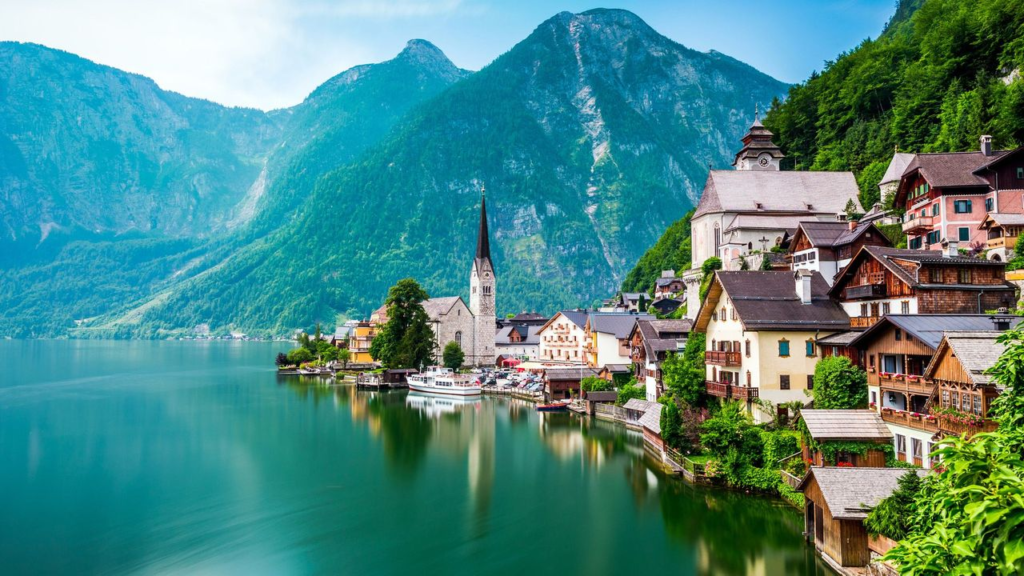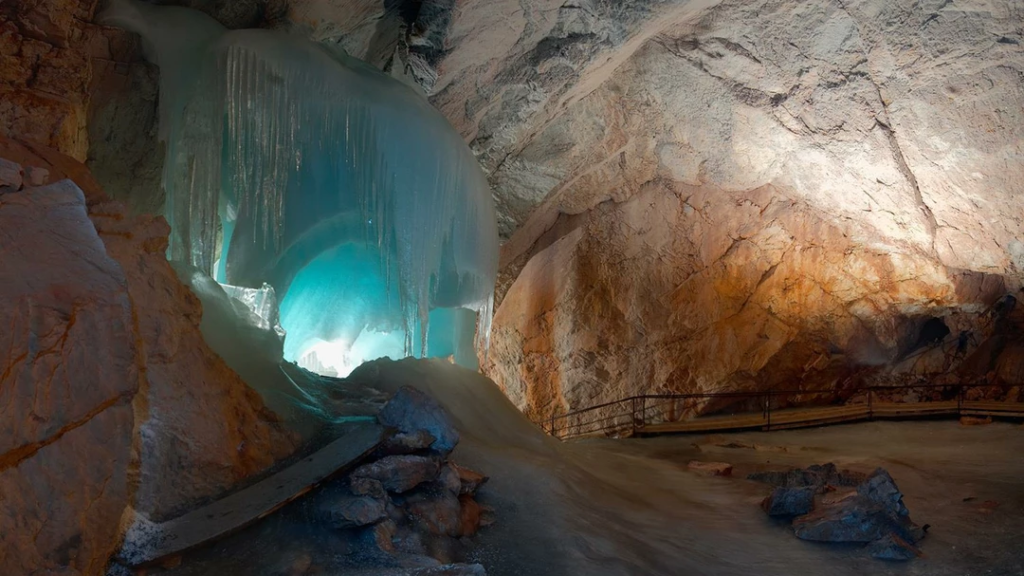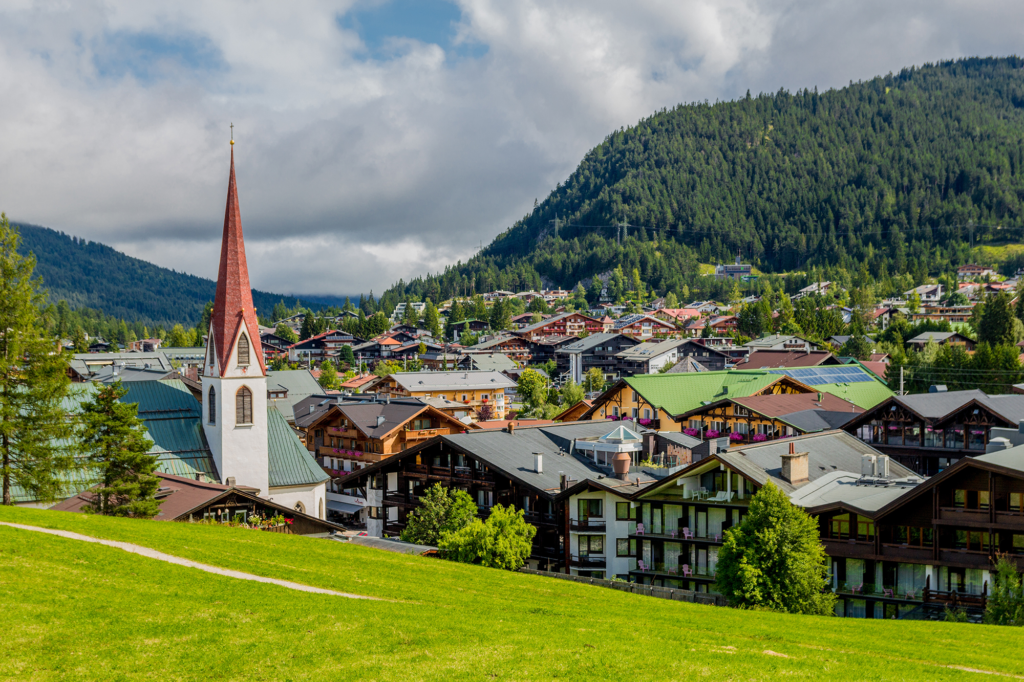Austria, a landlocked country nestled in the heart of Europe, is renowned for its stunning landscapes, rich cultural heritage, and historical significance. From the majestic Alps to the vibrant cities, Austria offers a symphony of experiences that captivate travelers and locals alike. This blog delves into the various facets of Austria, exploring its geography, history, culture, and unique characteristics.
Table of Contents
Geography
Austria is situated in Central Europe and shares borders with Germany, the Czech Republic, Slovakia, Hungary, Slovenia, Italy, Switzerland, and Liechtenstein. Covering an area of approximately 83,879 square kilometers, Austria is characterized by its diverse topography. The western and southern regions are dominated by the Alps, while the eastern part of the country features the lowlands of the Pannonian Basin. The Danube River, one of Europe’s longest rivers, flows through the northern part of Austria, adding to the country’s geographical significance.
The highest peak in Austria is the Grossglockner, standing at 3,798 meters, offering breathtaking views and a haven for mountaineers. Austria’s varied landscape includes picturesque valleys, rolling hills, and expansive forests, making it a paradise for nature lovers. The country experiences a temperate and alpine climate, with cold winters and warm summers, ideal for both winter sports and summer activities.
States of Austria
Austria is divided into nine federal states, known as “Bundesländer.” Each state has its own unique cultural and geographical characteristics. The nine states are:
| No. | State | Capital |
|---|---|---|
| 1 | Burgenland | Eisenstadt |
| 2 | Carinthia (Kärnten) | Klagenfurt |
| 3 | Lower Austria (Niederösterreich) | St. Pölten |
| 4 | Upper Austria (Oberösterreich) | Linz |
| 5 | Salzburg | Salzburg |
| 6 | Styria (Steiermark) | Graz |
| 7 | Tyrol (Tirol) | Innsbruck |
| 8 | Vorarlberg | Bregenz |
| 9 | Vienna (Wien) | Vienna |
Historical Overview
Austria’s history is a tapestry woven with various influences, from ancient Celtic tribes to the powerful Habsburg dynasty. The region that is now Austria has been inhabited since prehistoric times, with significant Celtic and Roman settlements. In the Middle Ages, Austria emerged as a duchy and later became a powerful player in European politics under the Habsburgs.
The Habsburg Monarchy, which began in the late 13th century, transformed Austria into a dominant force in Central Europe. The empire expanded significantly, encompassing territories across Europe and influencing the cultural and political landscape of the continent. The Austro-Hungarian Empire, formed in 1867, further cemented Austria’s influence until its dissolution after World War I.
The interwar period and the aftermath of World War II were challenging times for Austria, marked by political upheaval and economic difficulties. The country regained stability and prosperity in the post-war era, becoming a neutral and democratic republic in 1955. Austria’s accession to the European Union in 1995 further integrated it into the global community, enhancing its political and economic stature.
Cultural Heritage
Austria boasts a rich cultural heritage that has significantly influenced art, music, literature, and philosophy. The country is famously associated with classical music, being the birthplace of legendary composers such as Wolfgang Amadeus Mozart, Ludwig van Beethoven, and Franz Schubert. Vienna, the capital city, is often referred to as the “City of Music,” hosting numerous concerts, operas, and music festivals.
Austrian literature has also made a profound impact, with notable writers like Franz Kafka, Arthur Schnitzler, and Stefan Zweig. The country’s literary tradition reflects its complex history and diverse cultural influences, offering insights into the human condition and societal changes.
Austria’s artistic legacy is evident in its magnificent architecture, ranging from medieval castles and baroque palaces to modernist buildings. The Schönbrunn Palace, Hofburg Palace, and Belvedere Palace are architectural marvels that showcase the opulence and grandeur of Austria’s past. The country is also home to world-class museums and art galleries, such as the Kunsthistorisches Museum and the Albertina, which house invaluable collections of art and historical artifacts.
Top Ten Must-Visit Destinations
Austria, known for its breathtaking landscapes and rich cultural heritage, offers a variety of unique destinations that captivate travelers. Here are ten must-visit destinations in this enchanting country, each offering a distinct experience.
1. Schönbrunn Palace

Schönbrunn Palace, located in Vienna, is one of Austria’s most significant cultural landmarks. This Baroque palace, once the summer residence of the Habsburgs, boasts 1,441 rooms, each more opulent than the last. Visitors can explore the stunning state rooms, the Great Gallery, and the Hall of Mirrors. The palace’s extensive gardens, featuring the Neptune Fountain, the Gloriette, and the world’s oldest zoo, Schönbrunn Zoo, offer a delightful experience for all ages.
2. Hallstatt

Hallstatt, a picturesque village nestled between the Hallstätter See and the Dachstein Alps, is renowned for its stunning natural beauty and historical significance. The Hallstatt Salt Mine, one of the world’s oldest, offers guided tours that delve into the region’s ancient salt mining history. The village itself is a UNESCO World Heritage Site, known for its charming streets, quaint houses, and the breathtaking view from the Hallstatt Skywalk, which extends over 350 meters above the ground.
3. The Grossglockner High Alpine Road

The Grossglockner High Alpine Road is a scenic route that offers an unforgettable driving experience through the heart of the Austrian Alps. This 48-kilometer road winds through the Hohe Tauern National Park, providing spectacular views of Austria’s highest peak, the Grossglockner, which stands at 3,798 meters. Along the way, visitors can stop at various viewpoints, hike trails, and visit the Kaiser-Franz-Josefs-Höhe Visitor Center to learn more about the region’s unique flora and fauna.
4. Melk Abbey

Perched high above the Danube River, Melk Abbey is a magnificent Benedictine monastery and a masterpiece of Baroque architecture. Founded in 1089, the abbey has been a center of learning and culture for centuries. Visitors can explore the ornate Marble Hall, the stunning library with its vast collection of medieval manuscripts, and the abbey church, adorned with intricate frescoes and gilded details. The abbey’s gardens offer panoramic views of the surrounding Wachau Valley, a UNESCO World Heritage Site known for its vineyards and rolling hills.
5. Eisriesenwelt Ice Cave

The Eisriesenwelt Ice Cave, located in the Tennengebirge mountains near Werfen, is the largest ice cave in the world. Stretching over 42 kilometers, this natural wonder offers a mesmerizing underground world of ice formations and frozen waterfalls. Guided tours take visitors through the first kilometer of the cave, where they can marvel at the Great Ice Embankment, the Eistor ice formations, and the Hymir Hall, named after a giant from Norse mythology.
6. Hohenwerfen Castle

Hohenwerfen Castle, perched on a rocky outcrop in the Salzach Valley, is a medieval fortress that dates back to the 11th century. The castle’s strategic location offers breathtaking views of the surrounding mountains and valleys. Visitors can explore the castle’s historic rooms, including the chapel, armory, and the Falconry Museum, which showcases the art of falconry. The castle also hosts regular falconry demonstrations, where visitors can witness these majestic birds in action.
7. Krimml Waterfalls

The Krimml Waterfalls, located in the Hohe Tauern National Park, are the highest waterfalls in Austria, with a total height of 380 meters. The falls are divided into three stages, each offering stunning views and the soothing sound of cascading water. A well-maintained trail allows visitors to hike up to the top of the falls, providing various vantage points to appreciate the natural beauty and power of the waterfalls. The nearby WasserWelten Krimml provides interactive exhibits on the importance of water and the natural environment.
8. Seefeld in Tirol

Seefeld in Tirol is a picturesque alpine village that offers year-round outdoor activities and breathtaking natural scenery. Located in the Tyrolean Alps, Seefeld is known for its world-class cross-country skiing and winter sports facilities. In the summer, visitors can enjoy hiking, mountain biking, and golfing in the surrounding meadows and forests. The village itself boasts charming streets, traditional Tyrolean architecture, and a variety of shops, cafes, and restaurants.
9. Mauthausen Memorial

The Mauthausen Memorial, located near Linz, is a poignant reminder of Austria’s history during World War II. The site was once a Nazi concentration camp, and today it serves as a memorial and museum dedicated to the victims. Visitors can explore the preserved camp structures, including the barracks, the quarry, and the gas chamber. The museum offers detailed exhibits on the history of the camp, the Holocaust, and the stories of the survivors, providing a somber and educational experience.
10. Wachau Valley

The Wachau Valley, a UNESCO World Heritage Site, is a picturesque region along the Danube River, known for its scenic beauty, historic towns, and vineyards. The valley stretches from Melk to Krems and is dotted with charming villages, ancient monasteries, and medieval castles. Visitors can take a leisurely boat cruise along the Danube, explore the historic town of Dürnstein, and sample the region’s renowned wines in one of the many local wineries. The Wachau Valley’s combination of natural beauty and cultural heritage makes it a must-visit destination in Austria.
Top Ten Most Beautiful Village
| No. | Village | Location |
|---|---|---|
| 1 | Hallstatt | Hallstätter See, Salzkammergut Region |
| 2 | Alpbach | Alpbachtal Valley, Tyrol |
| 3 | Zell am See | Lake Zell, Salzburg Region |
| 4 | Dürnstein | Wachau Valley, Lower Austria |
| 5 | Maria Alm | Hochkönig Region, Salzburg |
| 6 | St. Wolfgang | Wolfgangsee, Salzkammergut Region |
| 7 | Heiligenblut | Großglockner, Carinthia |
| 8 | Filzmoos | Dachstein, Salzburg Region |
| 9 | Pertisau | Achensee, Tyrol |
| 10 | Bad Gastein | Gastein Valley, Salzburg |
Festivals and Traditions
Austria’s vibrant culture is celebrated through its numerous festivals and traditions. The Viennese Ball Season, a highlight of Austria’s social calendar, features elegant balls held in historic venues, where attendees waltz to classical music in a display of timeless elegance. The Salzburg Festival, one of the world’s most prestigious music and drama festivals, attracts artists and audiences from around the globe.
Traditional Austrian festivals, such as the Almabtrieb and Krampusnacht, reflect the country’s rural heritage and folklore. Almabtrieb marks the return of cattle from mountain pastures to the valleys, celebrated with parades, music, and traditional costumes. Krampusnacht, a unique pre-Christmas tradition, features the Krampus, a mythical creature who accompanies Saint Nicholas to punish naughty children, adding a touch of folklore and excitement to the holiday season.
Cuisine
Austrian cuisine is a delightful fusion of flavors and influences, reflecting the country’s diverse cultural heritage. Traditional dishes such as Wiener Schnitzel, Tafelspitz, and Apfelstrudel are renowned for their deliciousness and are enjoyed by locals and visitors alike. Austrian pastries and desserts, including Sachertorte and Linzer Torte, are celebrated for their rich flavors and intricate preparation.
Vienna is famous for its coffeehouse culture, where coffeehouses serve as social hubs for intellectuals, artists, and everyday citizens. The tradition of enjoying a cup of coffee with a slice of cake in a cozy coffeehouse is an integral part of Austrian life, providing a charming glimpse into the country’s leisurely lifestyle.
Top Eight Most Famous Food of Austria








Language and Education
German is the official language of Austria, spoken by the majority of the population. Austrian German, with its distinct regional dialects, reflects the country’s historical and cultural diversity. In addition to German, various minority languages, including Hungarian, Slovenian, and Croatian, are spoken in different regions, highlighting Austria’s multiculturalism.
Austria places a strong emphasis on education, with a well-developed system that includes compulsory schooling and a range of higher education institutions. The country is home to prestigious universities, such as the University of Vienna and the Graz University of Technology, which attract students and researchers from around the world.
Economy and Industry
Austria has a highly developed and diverse economy, characterized by a mix of industries, including manufacturing, services, and tourism. The country is known for its high standard of living and robust social welfare system, which contributes to its citizens’ overall well-being.
Key industries in Austria include machinery, steel, chemicals, and electronics. The automotive industry is particularly significant, with Austria serving as a hub for automotive engineering and manufacturing. Additionally, Austria is a global leader in environmental technology and renewable energy, reflecting its commitment to sustainability and innovation.
Tourism plays a vital role in Austria’s economy, attracting millions of visitors each year who come to explore the country’s natural beauty, cultural heritage, and historical sites. The Austrian Alps are a major draw for winter sports enthusiasts, while the picturesque countryside and charming cities appeal to a wide range of tourists.
Political Structure
Austria is a federal republic with a parliamentary system of government. The President serves as the head of state, while the Chancellor is the head of government. The bicameral parliament consists of the National Council and the Federal Council, which work together to enact legislation and govern the country.
Austria’s political landscape is characterized by a commitment to neutrality and diplomacy. The country is an active member of the European Union, the United Nations, and various international organizations, playing a significant role in global affairs and promoting peace and cooperation.
Environmental Initiatives
Austria is renowned for its commitment to environmental conservation and sustainability. The country’s stunning natural landscapes are protected through various national parks and conservation areas, ensuring the preservation of its biodiversity and ecosystems.
Austria is a pioneer in renewable energy, with a significant portion of its energy needs met through hydropower, wind, and solar energy. The country has implemented stringent environmental regulations and initiatives to reduce carbon emissions, promote recycling, and encourage sustainable practices across industries and communities.
Conclusion
Austria, with its breathtaking landscapes, rich cultural heritage, and commitment to sustainability, is a country that offers a harmonious blend of tradition and modernity. From its majestic Alps to its vibrant cities, Austria captivates the hearts of those who visit and those who call it home. Whether through its classical music, architectural marvels, or culinary delights, Austria continues to be a symphony of natural beauty and cultural richness, inviting exploration and appreciation from all who encounter it.

